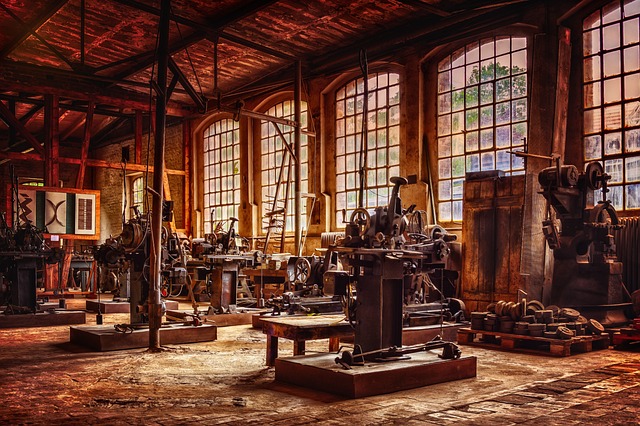
This article delves into the evolution of machinery, its impact on industry, society, and economy, highlighting its profound transformation from its inception to modern innovations.
The machine age began in the late 18th century during the Industrial Revolution, marked by early machines like the spinning jenny and steam engine. These inventions increased productivity and efficiency, transforming production from manual labor to industrial powerhouses, transforming urban landscapes, and setting the stage for modern industry.
James Watt’s 1770s steam engine revolutionized industrial machinery, replacing human and animal labor and enabling faster transportation of raw materials and finished goods. This interconnectedness accelerated industrialization across continents and societal changes, such as urbanization, as people sought factory jobs, altering living patterns and economic structures worldwide.
The second Industrial Revolution in the late 19th and early 20th centuries introduced electrification. Thomas Edison and Nikola Tesla’s advancements in electricity changed machinery development and usage. Electric motors replaced steam engines, bringing about quieter, more efficient, and more flexible factory operations. This period also marked the advent of mass production techniques, exemplified by Henry Ford’s assembly line, which revolutionized manufacturing processes. Electrification allowed industries to explore new technologies, improve production accuracy, and enhance workers’ safety and working conditions, propelling industrial capabilities further.
Automation began transforming industries in the mid-20th century, reducing the need for human intervention in repetitive tasks. The introduction of computers and programmable logic controllers (PLCs) allowed machines to perform complex sequences with precision and speed. Automation improved efficiency, consistency, and safety in manufacturing processes. It also facilitated new production methodologies, such as Just-In-Time (JIT) manufacturing, minimizing waste and optimizing resource use. Over time, automation has continuously evolved, integrating artificial intelligence (AI) and robotics to push the boundaries of what machinery can accomplish.
Precision machinery entered the industrial scene in the latter half of the 20th century, with Computer Numerical Control (CNC) technology leading the charge. CNC machines, controlled by computer programs, allow for the precise cutting, shaping, and drilling of materials based on digital designs. This advancement drastically increased the complexity and quality of products that could be manufactured. Industries like aerospace, automotive, and healthcare benefited immensely from CNC technology, producing components with high precision and reliability. This development marked a significant leap towards highly specialized and customized manufacturing capabilities.
Industry 4.0, or the Fourth Industrial Revolution, is characterized by the digitalization of manufacturing. The fusion of the Internet of Things (IoT), big data, cloud computing, and AI has created smart factories where machinery communicates and self-optimizes. This interconnected environment enhances efficiency and predictive maintenance, reducing downtime and operational costs. Real-time data analytics empower manufacturers with insights for continuous improvement. Industry 4.0 represents a significant leap towards a fully automated and intelligent industrial ecosystem, marrying digital and physical production worlds to create unprecedented innovation and productivity levels.
With growing environmental concerns, sustainability in machinery has become a focal point. Innovations in eco-friendly technologies aim to reduce carbon footprints and conserve resources. Renewable energy sources, like solar and wind power, are increasingly used to run industrial machinery. Energy-efficient designs, such as advanced electric motors and waste heat recovery systems, contribute to lower energy consumption. Furthermore, circular economy principles encourage the reuse, recycling, and remanufacturing of machinery components. These initiatives reflect the industry’s commitment to fostering economic growth without compromising the planet's health.
Looking ahead, the future of industrial machinery holds exciting possibilities. Advances in AI, machine learning, and quantum computing promise to enhance machine capabilities further. Autonomous machines that can learn and adapt independently might become commonplace. Innovations like 3D printing bring us closer to decentralized manufacturing, where products can be produced on-demand, anywhere. Additionally, advancements in nanotechnology could lead to the development of machines with unprecedented precision and functionality. As technology continues to evolve, industrial machinery will play an increasingly pivotal role in shaping the future of production and human progress.
The transformation of industry through machinery, from the steam engine to smart factories, highlights a journey of relentless innovation and adaptation. Machinery has indisputably catalyzed economic growth, improved quality of life, and revolutionized global trade and production systems. As we stand at the cusp of unprecedented technological advancements, the role of machinery in industry continues to evolve. Embracing sustainability and integrating cutting-edge technologies will ensure that machinery not only drives industrial progress but also aligns with ecological and societal wellbeing. The ongoing evolution of machinery underscores its enduring significance, hinting at a future where human ingenuity and technological prowess will continue to intersect, driving innovation and prosperity for all.